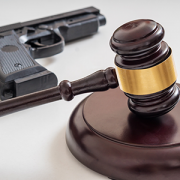Stronger firearm laws reduce ED visits

Children’s National researchers Sabah F. Iqbal, M.D., Shilpa J. Patel, M.D., and Monika K. Goyal, M.D., M.S.C.E., found that regions of the United States with the strictest gun laws also have fewer emergency department visits for pediatric firearm-related injuries.
A new study by researchers from Children’s National Health System find that regions of the United States with the strictest gun laws also have the fewest emergency department visits for pediatric firearm-related injuries. The work is among the few studies to evaluate the association between local laws and firearm-related injury to children and youth. The results, presented at the 2017 annual meeting of the Pediatric Academic Societies, could inform policies at the state and regional levels.
“Our results suggest an association between regional gun laws and firearm-related injuries in children,” says Monika K. Goyal, M.D., M.S.C.E., director of research within Children’s Division of Emergency Medicine and senior author of the poster. “Regions with stricter gun laws had lower incidence rates of firearm-related emergency department visits by children.”
Firearm-related injuries are a leading cause of death and disability among children and adolescents in the United States. It is well established that states with more restrictive gun laws have fewer firearm-related fatalities. However, it has been unclear how these laws affect the rates of firearm-related injuries among children.
To investigate this question, Children’s National researchers gathered data from the Nationwide Emergency Department Sample (NEDS), a set of hospital-based emergency department databases created by the federal Agency for Healthcare Research and Quality to aggregate data about emergency department visits across the country. The researchers matched NEDS data from 2009 to 2013 in patients 21 and younger with state-level Brady Gun Law Scores, a measure of the strength of firearm laws, in four geographic regions: The Midwest, Northeast, South and West.
The researchers found that during this five-year study period, there were 111,839 emergency department visits for pediatric firearm-related injuries nationwide, an average of 22,368 per year. The mean age of patients was 18 years, and the vast majority was male. Just over one-third were publicly insured. About 30 percent of these recorded injuries resulted in hospital admission, and about 6 percent resulted in death.
Overall, firearm-related visits to emergency departments remained consistent over time at a rate of 65 per every 100,000 visits until 2013, when they decreased slightly to 51 per 100,000 visits. However, these rates varied significantly by geographic region. The Northeast had the lowest rate at 40 per 100,000 visits. This was followed by the Midwest, West and South at 62, 68 and 71 per 100,000 visits, respectively.
These numbers roughly matched the Brady Gun Law Scores for each region. The Northeast had the highest Brady score at 45, followed by 8, 9 and 9 for the South, West and Midwest.
These findings, the study authors say, suggest that stricter gun laws might lead to fewer fatalities as well as fewer gun-related injuries among children. Future studies about the role of regional gun culture and its impact on firearm legislation at the regional level, they say, is an important next step in advocating for changes to firearm legislation and reducing pediatric firearm-related injuries.
“Future research work should seek to elucidate the association of specific gun laws with the incidence rates of pediatric firearm-related injuries,” says Shilpa Patel, M.D., M.P.H., an assistant professor of pediatrics and emergency medicine at Children’s National and co-author of the poster. “This work also could evaluate how regional differences — such as social gun culture, gun ownership and other factors — contribute to the significant regional variation in firearm legislation.”
The American Academy of Pediatrics, an organization of 66,000 pediatricians, has repeatedly advocated for stricter gun laws, violence prevention programs, research for gun violence prevention and public health surveillance, physician counseling to patients on the health hazards of firearms and mental health access to address exposure to violence.









